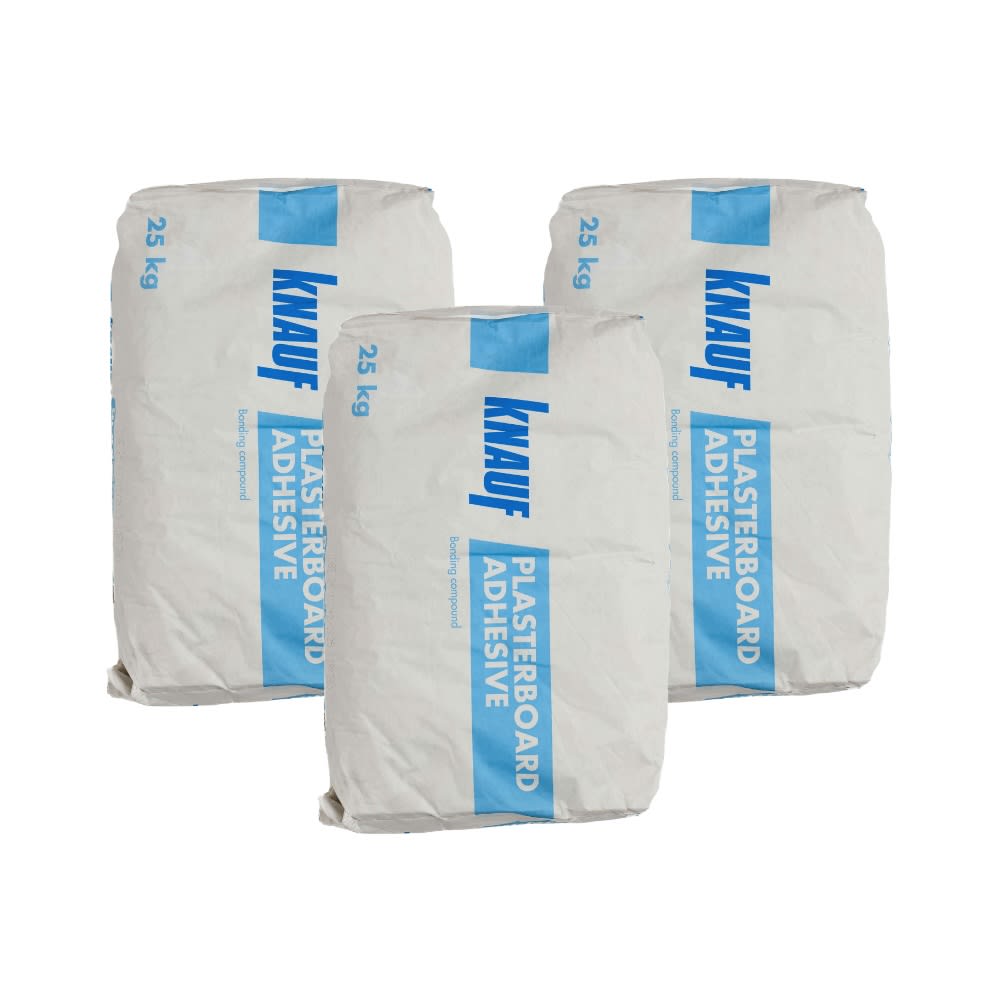Plasterboard & Drywall Adhesive
(3 Products)Drywall Adhesive (otherwise known as Bonding Compound) is an essential component in the installation of both standard and insulated plasterboard. It bonds boards directly to the wall in a process known as "dot and dab". This method is significantly quicker than building a stud wall and generally requires less technical skill.
What Is Plasterboard Adhesive?
Plasterboard adhesive is a specialised bonding agent used to secure plasterboard panels to walls or ceilings during construction or renovation projects.
Formulated to provide a strong, lasting connection, it typically consists of a gypsum-based powder mixed with water and may include polymers or setting agents to improve workability and adhesion.
Applied either in dabs or as a continuous layer, the adhesive fills gaps, aids in alignment, and allows some flexibility in positioning before it sets.
Its use ensures that the plasterboard is affixed securely, creating a smooth, uniform surface that is ready for finishing with paint or wallpaper.
Applications
Plasterboard adhesives fix plasterboard to a wall, creating a strong bond with a variety of material types.
They are commonly used when:
- Fixing insulation boards to masonry (to enhance thermal performance)
- Lining shower areas or bathrooms before applying the final finish
- Upgrading or preparing existing building substrates
- Applying decorative or functional finishes to solid walls
What Is Dot And Dab?
As the name would suggest, a dot and dab wall, otherwise known as a drylined wall, involves making small ‘dabs’ of plasterboard adhesive across a wall surface and then pressing it into place.
This technique is often used when the substrate to which the plasterboard is being fixed is uneven, as it helps to create a smooth, level surface without using wet plaster.
Since you are avoiding the faff of wet plastering, you can also paint your application in record time - bonding plasterboard to walls cuts out the lengthy applying and drying times associated with wet plaster.
Dot & Dab Equipment Essentials
- Plasterboard
- Adhesive
- Clean mixing stick & bucket
- Paint scraper/trowel
- Measuring tape
- Straight edge
- Spirit level
- Nails & hammer or power drill and screws (these are not usually required unless very heavy or additional adhesion is required for performance).
Fixings may be used to supplement adhesive in ceilings or with heavier boards, especially in high-traffic areas or where additional support is needed.
How to Apply Drywall Adhesives
To attach plasterboard adhesive via the dot and dab method, follow these steps:
- Mix the adhesive with water (to the manufacturer's recommendation) in a clean bucket until the mixture achieves a thick creamy consistency
- Should the mixture be too runny, add more adhesive powder to the mix until it thickens to a more workable consistency
- Once you have established the optimum consistency, begin applying the mixture in dabs, every 12 inches or so
- We recommend applying a continuous solid line of adhesive around the plasterboard prior to fixing to fully secure the panels
- Ensure to apply another line of adhesive just above the line of skirting boards
For more information on dot and dab fixing, take a look at our informative dot and dab article, where we delve into the step-by-step process of making a plasterboard wall.
How To Dot & Dab Insulated Plasterboard
Installing insulated plasterboard with dry wall adhesive is a straightforward process that requires no specialist methods.
- First, raise the board and hold it against the wall, ensuring all edges are straight and level.
- Once you have applied the adhesive, press the plasterboard onto the wall and hold it firmly until you are sure it is attached.
- If you have any concerns about the plasterboard being straight and level, a feather edge tool can be used to ensure a smooth surface, as its edges are straight by design.
Frequently Asked Plasterboard Adhesive Questions
How Do I Choose The Right Adhesive For My Project?
There are a few things to consider when choosing the right plasterboard adhesive.
The first is the type of wall you're working with. If your wall is masonry, then dot and dab will be the easiest way to fix the plasterboard.
If your wall is made of wood or metal studs, then you should use a different technique, such as screwing or nailing the boards into place.
You’ll also need to take into account the weight of the plasterboard. If the board is too heavy, then the dot and dab may not be strong enough to attach the plasterboard and hold it in place. In this case, you may want to screw or nail the boards into place for additional security.
Also, in some fire-rated or high-rise applications, dot and dab may not comply with building regulations due to potential voids behind the boards. Always check local building codes.
For those wanting to save time, fast-curing adhesive foam offers a more rapid installation process. Although it is performatively the same as drywall adhesive, it requires no mixing prior to application.
How Thick Should Plasterboard Adhesive Be?
The standard thickness of adhesive dabs tends to be around 10mm once compressed between the board and the substrate.
You also have the additional 12.5mm of the plasterboard sheets on top of this so, with thicknesses combined, you can expect an altogether depth of around 22.5mm.





